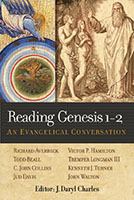Introduction
The material for this book originated at a symposium held at the Bryan Institute for Critical Thought & Practice. Scholars Richard Averbeck, Todd Beall, C. John Collins, Tremper Longman III, and John Walton presented their positions and dialogued with one another. In this book they each contribute a chapter stating their understanding of Genesis 1-2, and also provide a short response to the other contributors’ chapters. These scholars present very diverse interpretations of Genesis. Some of their views overlap significantly, but it is apparent that some models are radically dissimilar in terms of both the big picture and the smaller textual details. Some of the contributors are unsure if Adam was a real person, while others believe the entire account is to be read as six literal twenty-four hour time periods during which God created the material world. It is argued that the account is concerned with material origins; it is also argued that the account has nothing to say about material origins. Some insist that parallel literature from the Ancient Near East (ANE) is crucial for understanding how to interpret Genesis 1-2, while others find it interesting but unnecessary. There are debates about purpose, genre, the number of creation accounts, the way Genesis 1-2 fits together, the way these chapters fit with the rest of Genesis, the way Christ and Paul understood Adam, and far more.
After the five chapters and the responses to them, there are two additional chapters. The first of these deals with pedagogy and Genesis 1-2. How can a professor teach these chapters in an undergraduate setting? What should be said, what approach should be taken, etc.? The second chapter provides a critical assessment of what issues need to be explored more carefully. It is written by someone inclined to the traditional, literal interpretation of the creation account. Seven areas for further exploration are identified.
Explanatory Note: Due to the short nature of the responses, they will not be summarized in what follows. Frequently the responder identifies points of disagreement, but their reasons for rejecting other positions are normally embedded in their own chapters. By reading their own presentations it is easy to see the main places where the contributors agree or disagree. The responses are a very helpful part of the dialogue, but their length means they are already bordering on summaries themselves.
Table of Contents
Introduction
Chapter 1 A Literary Day, Inter-Textual, and Contextual Reading of Genesis 1-2
Four Responses to Chapter One
Chapter 2 Reading Genesis 1-2: A Literal Approach
Four Responses to Chapter Two
Chapter 3 Reading Genesis 1-2 with the Grain: Analogical Days
Four Responses to Chapter Three
Chapter 4 What Genesis 1-2 Teaches (and What It Doesn’t)
Four Responses to Chapter Four
Chapter 5 Reading Genesis 1 as Ancient Cosmology
Four Responses to Chapter Five
Chapter 6 Teaching Genesis 1 at a Christian College
Chapter 7 Unresolved Major Questions: Evangelicals and Genesis 1-2
Summary
Chapter 1. A Literary Day, Inter-Textual, and Contextual Reading of Genesis 1-2
By Richard Averbeck
The creation account in Genesis reveals that the covenant Lord of Israel is also the sole creator of the world. It is extremely important to pay attention to the literary features of the account, as well as to compare it inter-textually with other biblical passages. There are ANE texts that need to be studied as well, but the ANE texts cannot control our interpretation of the Scriptures.
Genesis 1:1 is an independent clause that …
[To continue reading this summary, please see below....]The remainder of this article is premium content. Become a member to continue reading.
Already have an account? Sign In
Buy the books

Reading Genesis 1-2